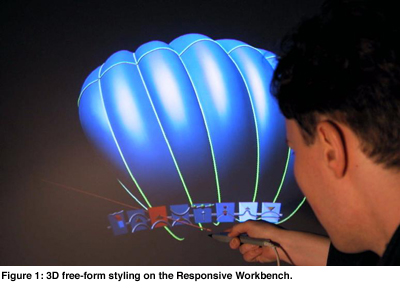
ERCIM News No.44 - January 2001 [contents]

![]()
ERCIM News No.44 - January 2001 [contents]
by Gerold Wesche and Marc Droske
A two-handed styling system for free-form surfaces, which runs directly in a table-like Virtual Environment, called the Responsive Workbench, has been developed at GMD. The user sees the model in 3D through stereo glasses, which are electromagnetically tracked. Curves can be drawn directly in 3D using a tracked, pen-like input device, called stylus. The curves are connected automatically, such that a curve network develops. Inside the loops, surfaces can be computed. Intuitive curve and surface deformation tools hide the mathematical representation from the designer.
Many designers would like to sketch free-form shapes quickly in the conceptual design phase without using a complex CAD system. Projection-based Virtual Environments like the Responsive Workbench offer the following advantages for sketching applications over traditinal desktop interfaces:
Our ambition is to support free-form styling capabilities on the Responsive Workbench. We provide the designer with intuitive deformation tools for curves and surfaces relying on familiar metaphors. Our basic approach is constructing curve nets by drawing cubic B-spline curves directly in space and creating surfaces inside the loops of the curve net, see Figure 1.

Features of the Modeler
In our system, cubic B-spline curves can be drawn freely in space. New curves are woven into the existing curve network automatically. If a closed loop of curve pieces has been formed, a surface patch can be created. We are using Catmull-Clark subdivision surfaces. A direct approach to modify the curves or surfaces of the network is to select individual control points and move them, changing the model locally. It is a very tedious task to bring the curve or surface into the desired shape with this technique. Higher level manipulation methods are needed, especially in a virtual environment.
Variational modelling techniques provide an elegant way of manipulating curves and surfaces. Attractors of intuitive behaviour can been defined, which minimize an energy functional and lead to fair and pleasant surfaces. Based on this technique, we developed the following intuitive operators, which can be applied locally or globally to curves and surfaces:
The non-dominant hand assists the modelling hand in drawing curves by controlling the position and orientation of a modelling coordinate system dynamically or by fixing it. Additionally, the non-dominant hand can control a virtual transparent drawing plane onto which curves are projected, or it applies symmetry planes globally or locally.
Future Work
The drawback of ‘interacting in the air’, which occurs particularly with regard to elastic deformations, will be attacked by integrating a large version of the PHANToM device into the workbench environment. In contrast to this, controlling the smoothing and sharpening tools described here works very well even without force feedback since the corresponding arm movements are rather indirect.
Conclusion
This article has presented a conceptual design system which supports the intuitive transfer of the design intent into virtual models. The tools are designed especially for free-form modelling applications in projection-based Virtual Environments. The modeler supports the quick input of surfaces by allowing the user to draw the primal curves of a model directly in 3D.
User studies have to evaluate the usefulness of the proposed techniques to suggest further improvements.
Links:
Institute for Media Communication: http://imk.gmd.de
Please contact:
Gerold Wesche - GMD
Tel: +49 2241 142708
E-mail: Gerold.Wesche@gmd.de